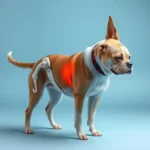
Introduction
As a responsible pet owner, ensuring the health and well-being of your dog is paramount. Among the various health indicators, eye health plays a crucial role in assessing overall canine wellness. One significant sign that requires attention is dilated pupils in dogs. Understanding the implications of dilated pupils can help you identify health issues early on, ensuring your furry friend gets the care they need. In this article, we will explore what dilated pupils mean, their causes, symptoms, and treatment options available for dogs.
Understanding Dog Eye Anatomy
Basic Eye Structure
To comprehend the significance of dilated pupils in dogs, it is essential to have a basic understanding of canine eye anatomy. A dog’s eye comprises several key components, including:
- Cornea: The transparent front layer that helps focus light.
- Lens: A flexible structure that adjusts to focus light onto the retina.
- Retina: The inner layer of the eye that converts light into neural signals, which are then sent to the brain.
- Pupil: The opening in the center of the iris that regulates the amount of light entering the eye.
The pupils play an essential role in vision by controlling light levels, allowing for optimal sight in varying conditions.
Function of Pupils
Pupils respond to light by constricting in bright conditions and dilating in low-light environments. This regulation of light entry is vital not only for vision but also for assessing a dog’s health. A normal pupillary response indicates that the nervous system and eye function properly. When pupils are dilated unexpectedly, it can signal underlying health issues that warrant investigation.
What Are Dilated Pupils?
Definition of Dilated Pupils
The medical term for dilated pupils in dogs is mydriasis. This condition occurs when the pupils are larger than normal and do not constrict appropriately in response to light. Normal pupil size varies depending on the dog’s breed and lighting conditions, but when the pupils remain dilated in bright light or do not constrict when they should, it can be a cause for concern.
Symptoms Associated with Dilated Pupils
Dilated pupils often accompany other symptoms that can offer clues about your dog’s health. Common symptoms to watch for include:
- Sensitivity to light: Dogs with dilated pupils may squint or avoid bright areas.
- Behavior changes: Increased anxiety, restlessness, or lethargy can indicate discomfort or distress.
- Discharge from the eyes: Any unusual discharge can signal an underlying issue.
- Vision problems: If your dog seems disoriented or has trouble navigating their environment, this could relate to eye health.
Observing your dog’s behavior and physical signs is crucial in identifying potential health problems.
Causes of Dilated Pupils in Dogs
Environmental Factors
Dilated pupils in dogs can result from environmental factors. Bright light or sudden changes in lighting can cause temporary dilation. Additionally, stress or excitement can trigger a physiological response, leading to mydriasis. For instance, a dog may have dilated pupils during a thunderstorm or a visit to the vet.
Medical Conditions
Several medical conditions can lead to persistent dilated pupils. Some of the most common include:
- Neurological disorders: Conditions affecting the nervous system can disrupt normal pupillary response.
- Eye injuries or infections: Trauma to the eye or infections like uveitis can cause dilation.
- Poisoning: Certain plants or chemicals can induce mydriasis as a symptom of toxicity.
- Glaucoma: This painful condition leads to increased intraocular pressure and can cause dilated pupils.
- Side effects of medications: Some medications, particularly those affecting the nervous system, can result in dilated pupils.
Age-Related Changes
As dogs age, their eyesight can change, influencing pupil response. Older dogs may exhibit persistent mydriasis due to age-related conditions such as cataracts or retinal degeneration. Monitoring your senior dog’s eye health becomes increasingly important to catch any issues early.
Diagnosing the Cause of Dilated Pupils
Veterinary Examination
If you notice dilated pupils in dogs, seeking veterinary care is essential. A veterinarian will perform a thorough examination to determine the underlying cause. Be prepared to discuss your dog’s health history, any recent changes in behavior, and the onset of symptoms.
Diagnostic Tests
Veterinarians may conduct various diagnostic tests to assess your dog’s condition. Common tests include:
- Blood tests: To check for infections, toxins, or metabolic issues.
- Imaging: X-rays or ultrasounds may be necessary to investigate potential injuries or abnormalities.
- Eye examinations: A detailed eye exam can help identify structural problems or diseases affecting the eye.
A comprehensive approach to diagnosis is crucial for effective treatment.
Treatment Options for Dilated Pupils
Home Care Strategies
If your dog has dilated pupils, monitoring their condition at home is essential. Here are some strategies:
- Create a calm environment: Reduce noise and bright lights that may stress your dog.
- Observe symptoms: Keep track of any changes in behavior or additional symptoms.
- Limit activities: Avoid vigorous play or exercise until you can consult a veterinarian.
Medical Treatments
Treatment for mydriasis will depend on the underlying cause. Potential medical treatments may include:
- Medications: Your veterinarian may prescribe medications to address underlying conditions, such as anti-inflammatories for eye issues or treatments for infections.
- Surgical options: In cases where structural problems are found, surgery may be necessary to correct the issue.
Follow-Up Care
Regular follow-up appointments are crucial in managing your dog’s eye health. During these visits, the veterinarian can monitor changes and adjust treatment plans as necessary. It’s important to report any new symptoms or concerns promptly.
Preventive Measures for Eye Health
Regular Veterinary Check-Ups
Preventive care plays a significant role in maintaining eye health. Regular veterinary check-ups allow for routine eye examinations, which can help identify potential issues before they become serious.
Safe Environment
Creating a safe home environment can protect your dog’s eye health. Here are some tips:
- Avoid toxic plants: Keep harmful plants out of your home and yard.
- Secure chemicals: Store cleaning supplies and chemicals safely to prevent accidental exposure.
Nutritional Support
A well-balanced diet can support eye health. Ensure your dog receives nutrients that promote eye function, including:
- Antioxidants: Vitamins C and E can help protect the eyes from oxidative damage.
- Omega-3 fatty acids: These are essential for maintaining healthy eyes and can be found in fish oil.
Conclusion
Understanding dilated pupils in dogs is crucial for every pet owner. By recognizing the significance of this symptom, you can take proactive steps to monitor your dog’s health and seek veterinary care when needed. Observing changes in your dog’s behavior and physical health is vital to their overall well-being. Proactive dog health care, including regular check-ups and creating a safe environment, plays a significant role in maintaining your beloved pet’s quality of life. Always remember, your attentiveness and care can make a world of difference in your dog’s health journey.









